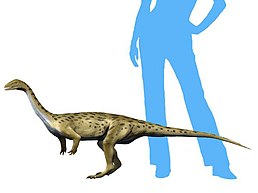Saturnaliinae
Stratigrafický výskyt: Svrchní trias, před 235 až 230 miliony let | |
|---|---|
 Rekonstrukce vzezření rodu Saturnalia | |
| Vědecká klasifikace | |
| Říše | živočichové (Animalia) |
| Kmen | strunatci (Chordata) |
| Třída | plazi (Sauropsida) |
| Nadřád | dinosauři (Dinosauria) |
| Řád | plazopánví (Saurischia) |
| Podřád | Sauropodomorpha |
| Čeleď | Guaibasauridae? |
| Podčeleď | Saturnaliinae Ezcurra, 2010 |
| Některá data mohou pocházet z datové položky. | |
Saturnaliinae byla podčeleď vývojově primitivních plazopánvých dinosaurů ze skupiny Sauropodomorpha, žijících na území dnešní Brazílie a Argentiny v období svrchního triasu (zhruba před 235 až 230 miliony let).
Historie a klasifikace
[editovat | editovat zdroj]Tento klad byl formálně stanoven v roce 2010.[1] Mohlo se jednat o samostatnou vývojovou skupinu, nezávislou na rodu Guaibasaurus.[2] Podle novějších srudií může být skupina Saturnaliinae dokonce samostatnou čeledí Saturnaliidae.[3]
Popis
[editovat | editovat zdroj]
Tito sauropodomorfové dosahovali malých rozměrů a vykazovali množství archaických, vývojově primitivních znaků. Jednalo se o menší dinosaury, dosahující délky kolem 1,5 metru[4] a hmotnosti asi 10[5] nebo 11[6] kilogramů. Mohlo se jednat o zástupce skupiny, zahrnující také pozdější obří sauropody.
Zástupci
[editovat | editovat zdroj]Odkazy
[editovat | editovat zdroj]Reference
[editovat | editovat zdroj]- ↑ Ezcurra, Martin D. (2010). "A new early dinosaur (Saurischia: Sauropodomorpha) from the Late Triassic of Argentina: a reassessment of dinosaur origin and phylogeny". Journal of Systematic Palaeontology. 8 (3): 371–425. doi: 10.1080/14772019.2010.484650
- ↑ Cecilia Apaldetti; Ricardo N. Martinez; Oscar A. Alcober & Diego Pol (2011). Claessens, Leon (ed.). "A New Basal Sauropodomorph (Dinosauria: Saurischia) from Quebrada del Barro Formation (Marayes-El Carrizal Basin), Northwestern Argentina". PLoS ONE. 6 (11): e26964. doi: 10.1371/journal.pone.0026964
- ↑ Langer M. C., McPhee B. W., Marsola J. Cd. A., Roberto-da-Silva L., Cabreira S. F. (2019). Anatomy of the dinosaur Pampadromaeus barberenai (Saurischia—Sauropodomorpha) from the Late Triassic Santa Maria Formation of southern Brazil. PLoS ONE, 14(2): e0212543. doi: https://doi.org/10.1371/journal.pone.0212543
- ↑ Holtz, Thomas R., Jr.; Rey, Luis V. (2007). Dinosaurs: The Most Complete, Up-to-Date Encyclopedia for Dinosaur Lovers of All Ages (Aktualizovaný internetový dodatek). New York: Random House. ISBN 978-0-375-82419-7.
- ↑ Paul, G. S. (2010). The Princeton Field Guide to Dinosaurs. Princeton University Press, str. 163 (anglicky)
- ↑ Benson, R. B., Hunt, G. , Carrano, M. T., Campione, N. and Mannion, P. (2018). Cope's rule and the adaptive landscape of dinosaur body size evolution. Palaeontology, 61: 13-48. doi: 10.1111/pala.12329
Literatura
[editovat | editovat zdroj]- Langer, M. C., Abdala, F., Richter, M., and Benton, M. (1999). "A sauropodomorph dinosaur from the Upper Triassic (Carnian) of southern Brazil." Comptes Rendus de l'Académie des Sciences, 329: 511-;517.
- Langer, M. C. (2003). "The pelvic and hind limb anatomy of the stem-sauropodomorph Saturnalia tupiniquim (Late Triassic, Brazil)." PaleoBios, 23(2): September 15, 2003.
- Bonaparte, J. F., Brea, G., Schultz, C. L., and Martinelli, A. G. (2007). "A new specimen of Guaibasaurus candelariensis (basal Saurischia) from the Late Triassic Caturrita Formation of southern Brazil." Historical Biology, 19(1): 73-82.
- Mario Bronzati, Max C. Langer & Oliver W. M. Rauhut (2019). Braincase anatomy of the early sauropodomorph Saturnalia tupiniquim (Late Triassic, Brazil). Journal of Vertebrate Paleontology, Article: e1559173. doi: https://doi.org/10.1080/02724634.2018.1559173
- Mario Bronzati, Rodrigo T. Müller & Max C. Langer (2019). Skull remains of the dinosaur Saturnalia tupiniquim (Late Triassic, Brazil): With comments on the early evolution of sauropodomorph feeding behaviour. PLoS ONE 14(9): e0221387. doi: https://doi.org/10.1371/journal.pone.0221387
Externí odkazy
[editovat | editovat zdroj]- SOCHA, Vladimír. Saturnalia - skutečný vánoční dinosaurus. OSEL.cz [online]. 25. prosince 2019. Dostupné online. (česky)